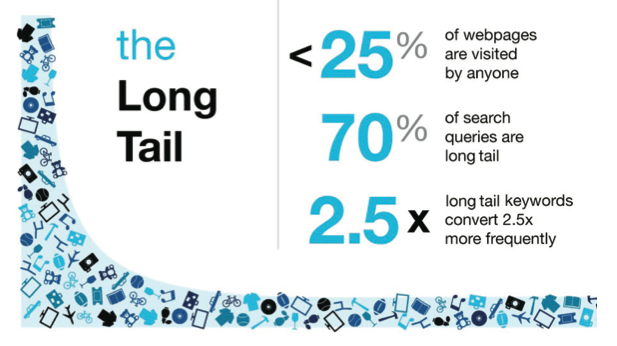The practice of search engine optimization (SEO) is evolving constantly. However, one thing that remains unchanged is that clients want to rank for a priority list of highly competitive terms. The goal of any website is to rank high for competitive keywords.
Keywords are meant for a different purpose and right keywords can play a key role in the success of your SEO campaign. It is important for people to use different tools for keyword research.
The long tail keywords can be quite mysterious to explore, lacking the volume data. The primary goal of companies is to optimize their website for “long tail keywords”.
In this post, I will help you find out some effective ways to target long tail keywords. After reading this post, you will learn how to get more traffic with long tail keywords?
Before that, let’s understand what are long tail keywords?
They are the keywords that have a good monthly search volume, but low competition. If I classify good monthly search volume as anything over 1,000 searches per month, then what I mean by low competition is the sites that occupy the first 10 places of Google can be beaten easily.
The key to SEO success is low competition with good monthly search volume. On the contrary, SEO failure can be a result of high monthly search volume and high competition.
We all know that targeting long tail keywords is not a sound strategy. But, when I dug into a client’s keyword strategy — I discovered that a forgotten long tail keyword was generating some valuable leads.
Now, for those who are not familiar with the demand curve in the search engine world – it is pretty tough to do keyword research in a low volume region. Long tail keywords and phrases that do not get enough search volume are really valuable for many businesses.
Why long tail keywords are important for SEO?
According to reports, more than 70% of search traffic comes from long tail keywords. However, many of these are business specific and can bring leads directly to your conversion pages. There are three main benefits of long tail keywords, which are as below –
● Specific to certain business
Long tail keywords are specific to a certain business, and hence the competition is between you and a few others only. The best thing about long tail keywords is that do not need much effort to rank well as compared to high-rank keywords.
If the targeted keywords are sufficiently specific, a great link building strategy for landing page could result in a higher ranking and conversion.
● Generate more conversions
The simple act of finding long tail keywords will help you what your audience is looking for. You will be able to solve queries of the user about any particular product or service by providing additional information.
When you have found everything, you can direct qualified leads to sales. Not only this, you will succeed in improving your content marketing efforts and conversion rate optimization.
● Optimize for semantic search
Long tail keyword plays an important role in optimizing for semantic search. Whenever the user performs a semantic search from different platforms, they use long tail keywords such as questions and command prompts. If you can predict the intent of the user behind the questions and provide relevant answers – you will surely improve your efforts in targeting long tail keywords.
Targeting long tail keywords can give immense value to your business, even if they have low search density.
Now, you have understood why you should use long tail keywords in your SEO strategy. Always remember that the long tail keyword strategy depends on the content you generate. If you are a beginner, start by creating content about the SEO industry.
Is it really easy to find long tail keywords?
Source: neilpatel.com
Now, you have understood the potential benefit of long tail or low volume keywords on your site growth. The internet is extremely competitive and many SEO firms take advantage of low competition keywords for their clients. So, it is difficult to find low competition keywords.
If you want your website to become an authority on a particular keyword, you should consider using “long tail keywords” of competitive search terms.
There are a number of tools to find variations of the keywords you want to target. Keywordtool.io is one such tool, using which you can find higher volume keyword terms.
Let’s dive in a bit deep to understand how to find low volume keywords or long tail keywords. Here, I am going to cover four basic topics, which are as below –
1. Understand keyword landscape
This is one of the effective ways to target long tail keywords. For this, you should be familiar with the most popular long tail permutations of your competitive keywords. Know what patterns people use in common and optimize your website around those keywords and patterns.
Define your keyword landscape by using your own analytics data, internal search data and SEO tools like – Google Adwords Keyword, Wordtracker etc.
For instance, if you want to sell ethnic wear and you see there is some search traffic around “black ethnic wear” you would optimize for all the other colours that you sell. It may help you create a page about “black ethnic wear” as well.
You may find that just by adding different colour names to your high ranking page does work well. In most of the cases, adding long tail keyword permutations to the body of the high-rank page can produce great results. Again, it depends on how competitive the long tail permutations are.
Once you have identified long tail keywords, you can use them for a piece of content. Use each long tail keyword for bullet points and subtitles. The main motto of finding long tail or low volume keywords is to improve the quality of your content and make it much relevant.
Long tail keywords address the need of searcher and tend to rank well on Google, compared to similar head keywords.
2. Create descriptive page titles
I am never fond of fan pages that are limited to 65 characters in length. There is a misconception that only the first 65 characters are recognized. But the fact is that the keywords after these 65 characters are also recognized and counted in ranking algorithms of major search engines.
If I place long tail keyword (long tail keyword permutations) after the 65th character — with an understanding that the first 65 characters capture user’s attention, then I will be able to target more number of keyword permutations. Not only this, I will be able to give search engines more information about the webpage.
You are conveying the message, as long as you are using descriptive page titles that are useful for users as well as search engines. I feel that this method is even loved by search engines, as I have never been flagged by webmaster tools for using long tail keywords in the page title.
3. Research long tail keywords
Many people think that the importance of keyword research has gone down. However, keyword research tools are as important as before —, particularly for long-tail keyword research. These tools can help you craft the right kind of content that engages your audience.
In research by Statista, it was found that long tail keywords play an important role in on-page optimization. The reason behind this is that the users conduct a long tail keyword search when he/she is more serious about the topic.
Many people asked me – “what should be the length of long tail keyword?” well, it should be four or more — as the longer the keyword, the easier it is to rank in search engine results.
Some of the best examples of good long tail keywords in “ethnic wear” are –
● Ethnic wear for ladies
● Ethnic wear for girls
● Ethnic wear online
● Best ethnic wear for men in India
● Best ethnic wear brands in India
● Best ethnic online stores for women
● Best ethnic wear for baby girl
● Best ethnic wear for baby boy
● Red colour ethnic wear for a party
Follow some simple steps to research your own long-tail keywords.
Step #1: Go to Google keyword planner and type in the basic keyword. The basic keyword I used in the above example was “ethnic wear”. Scroll down and click “get ideas”.
Step #2: Click on the keywords tab to find all the relevant keywords or phrases related to ethnic wear. Look at the most relevant and highly demanding keywords.
Step #3: Copy the relevant keywords and plug them into a search box to find long-tail variations. If you want to generate more than 50 long tail variations, you can take help of PPC tools.
4. Use long tail keywords and internal links in your content
You will find a number of long tail keyword permutations, which you can use to drive traffic to your website. For this, you have to infuse the long tail keywords in the existing content. It is better to keep a different internal text link that point to any given page.
Try to make use of different internal site links with different long tail keywords pointing to the page that targets those keywords. Make sure that they are linked from other pages on your website and are relevant to long tail keywords.
Remember that Google algorithm counts only the link text that is found in the source code. As the global navigation links are found first in the source code, any pages that are linked to from the global navigation won’t benefit from these variations found in the content.
However, using infusing long tail keywords in content and internal links is worth doing from the perspective of user experience.
Look for ways to infuse your pages with user-generated content, as such type of content targets long tail keyword permutations. Users may include long tail variations as they make relevant comments about your page content.
User-generated content can be a great source of long tail keywords and helps to make the content more valuable to users and search engines.
These are some of the ways that can help you target long tail keywords successfully. I hope these tips provide you with some actionable recommendations that help you increase the amount of organic search traffic.
Conclusion
The bottom line is – ranking for a long tail keyword could lead to a successful business. Finding long tail keywords that are related to your business is an easy task. All you need to do is obtain a list of seed keywords, use Google’s autocomplete suggestion feature and list-down all the related search suggestions. Once you have found long tail keywords that are relevant to your business, you can add them to your spreadsheet.
As you have prepared the list of potential keywords — filter and remove those that are irrelevant and do not represent user intent.
When you are done with the final list of long tail keywords, which are of course long tail keywords — you can add them to your content and optimize your pages.
Take note to measure your marketing efforts by tracking the the rankings and traffic while putting content for long tail keywords. You might discover more keywords that you can target, which will help you enhance your on-page SEO.
What are your thoughts about using long tail keywords to drive traffic? Leave your comments below!



